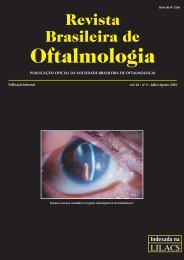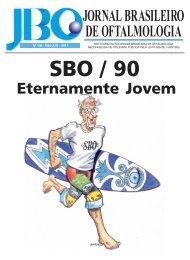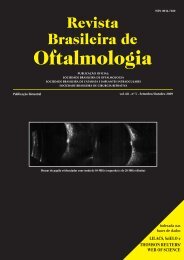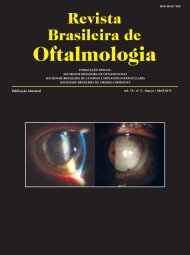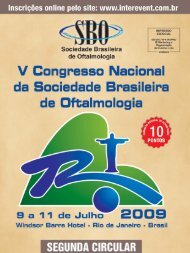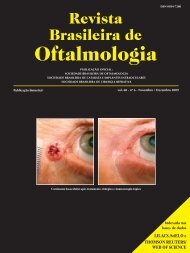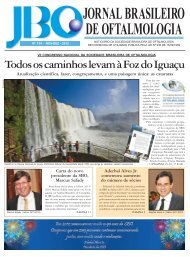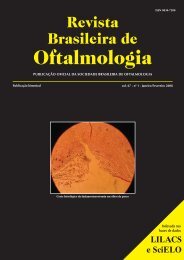Dynamic ultra high speed Scheimpflug imaging for assessing corneal biomechanical properties101Figure 3: Selected Scheimpflug image frames of a normal cornea during the measur<strong>em</strong>entin the radius of curvature at highest concavity in those subjectswho received treatment, consistent with increased stiffness.Subjects in the sham group showed no difference (p = 0.6981) atone month. Greater negative magnitu<strong>de</strong> in the radius of curvatureafter corneal collagen crosslinking or a flatter curvature atmaximum <strong>de</strong>formation was observed.DISCUSSIONFigure 4: Graphic display report of a normal thin (A) and mildkeratoconic cornea; (B) with the <strong>de</strong>formation amplitu<strong>de</strong> and cornealvelocity plots versus time(AL) and corneal velocities (CVel) are recor<strong>de</strong>d during ingoingand outgoing phases. Corneal thickness is also calculated throughthe horizontal Scheimpflug image. The lowest value is displayed.RESULTSFigures 3 and 4 summarize the Corvis ST findings in a normalthin cornea (Figures 3A and 4A), compared to one with mildkeratoconus (Figures 3B and 4B). Both corneas have relativelysimilar central corneal thickness of 500µm and similar IOP of14mmHg . The <strong>de</strong>formation of the ectatic cornea is morepronounced, having higher DA and corneal velocities. Theapplanation lengths in the ectatic cornea are smaller.Such parameters have been found useful for the diagnosisof ectasia (2) , as well as for assessing CXL results (Roberts,unpublished <strong>da</strong>ta 2011). In the FDA trial of corneal collagencrosslinking conducted at The Ohio State University, subjectswere evaluated biomechanically using the Corvis ST before an<strong>da</strong>fter the procedure. 11 keratoconic subjects randomly selectedfor the treatment group, were compared with 8 keratoconicsubjects randomly selected to be in the sham group. At one monthpost-procedure, a significant difference (p < 0.0014) was foundWe have <strong>de</strong>scribed a new technique for the non-invasiveimaging of the dynamic response of the cornea to an air puffduring NCT, using UHS Scheimpflug imaging. The inspection ofthe corneal slit during the <strong>de</strong>formation allows for objective andsubjective analysis. The different corneal responses to the same<strong>de</strong>formation stimuli obtained with the normal thin and mildkeratoconic cornea indicate that there are significant differencesin biomechanical properties <strong>de</strong>spite these corneas having similarthickness. The relative contribution of intraocular pressure inthe measur<strong>em</strong>ent is relatively eliminated in the example, as botheyes have similar IOP. In addition, the ability to evaluate the<strong>de</strong>formation response has the potential for d<strong>em</strong>onstrating clinicalevi<strong>de</strong>nce for biomechanically evaluating the effect of collagencrosslinking procedure. 20The retrieved <strong>da</strong>ta and <strong>de</strong>formation obtained by theCorvis ST provi<strong>de</strong> information related to the biomechanicalproperties of the tissue, including elasticity andviscoelasticity. Very importantly, the <strong>de</strong>formation <strong>da</strong>ta mayallow for more precise intraocular pressure measur<strong>em</strong>ents,which is also a significant influent of the <strong>de</strong>formationresponse. Therefore, the ultimate goal to un<strong>de</strong>rstand thebiomechanical properties of the corneal tissue and to measureIOP will have to be achieved together.The generated parameters can be integrated using linearand/or more advanced artificial intelligence algorithms forimproving the accuracy of <strong>de</strong>tecting disease and the impact ofsurgery. These parameters can be also used in combination withcorneal tomography and ocular biometry <strong>da</strong>ta.The integration of ultra-high-speed Scheimpflug imagingwith NCT has an enormous potential as a research and clinicaltool to retrieve in vivo biomechanical properties of the cornea.These measur<strong>em</strong>ents could be consi<strong>de</strong>red in finite el<strong>em</strong>ent mo<strong>de</strong>lsthat would improve diagnosis and prognosis of corneal diseasesand improve safety and efficacy of corneal surgery.Rev Bras Oftalmol. 2013; 72 (2): 99-102
102Ambrósio Jr R, Ramos I, Luz A, Faria FC, Steinmueller A, Krug M, Belin MW, Roberts CJREFERENCES1. Salomao MQ, Esposito A, Dupps WJ, Jr. Advances in anterior segmentimaging and analysis. Curr Opin Ophthalmol. 2009;20(4):324-32.2. Ambrosio R, Jr., Nogueira LP, Cal<strong>da</strong>s DL, Fontes BM, Luz A, CazalJO, et al. Evaluation of corneal shape and biomechanics before LASIK.Int Ophthalmol Clin. 2011;51(2):11-38.3. Dupps WJ, Jr., Wilson SE. Biomechanics and wound healing in thecornea. Exp Eye Res. 2006;83(4):709-20.4. Andreassen TT, Simonsen AH, Oxlund H. Biomechanical propertiesof keratoconus and normal corneas. Exp Eye Res. 1980;31(4):435-41.5. Roberts C. Biomechanical customization: the next generation of laserrefractive surgery. J Cataract Refract Surg. 2005;31(1):2-5.6. Liu J, Roberts CJ. Influence of corneal biomechanical properties onintraocular pressure measur<strong>em</strong>ent: quantitative analysis. J CataractRefract Surg. 2005;31(1):146-55.7. Congdon NG, Broman AT, Ban<strong>de</strong>en-Roche K, Grover D, Quigley HA.Central corneal thickness and corneal hysteresis associated with glaucoma<strong>da</strong>mage. Am J Ophthalmol. 2006;141(5):868-75.8. Kotecha A. What biomechanical properties of the cornea are relevantfor the clinician? Surv Ophthalmol. 2007;52 Suppl 2:S109-14.9. Brown KE, Congdon NG. Corneal structure and biomechanics: impacton the diagnosis and manag<strong>em</strong>ent of glaucoma. Curr Opin Ophthalmol.2006;17(4):338-43.10. Elsheikh A, Geraghty B, Rama P, Campanelli M, Meek KM. Characterizationof age-related variation in corneal biomechanical properties.J R Soc Interface. 2010;7(51):1475-85.11. Dupps WJ, Jr. Biomechanical mo<strong>de</strong>ling of corneal ectasia. J RefractSurg. 2005;21(2):186-90.12. Carvalho LA, Prado M, Cunha RH, Costa Neto A, Paranhos A, Jr.,Schor P, et al. Keratoconus prediction using a finite el<strong>em</strong>ent mo<strong>de</strong>l ofthe cornea with local biomechanical properties. Arq Bras Oftalmol.2009;72(2):139-45.13. Luce DA. Determining in vivo biomechanical properties of the corneawith an ocular response analyzer. J Cataract Refract Surg.2005;31(1):156-62.14. Knox Cartwright NE, Tyrer JR, Marshall J. Age-related differences inthe elasticity of the human cornea. Invest Ophthalmol Vis Sci.2011;52(7):4324-9.15. Jaycock PD, Lobo L, Ibrahim J, Tyrer J, Marshall J. Interferometrictechnique to measure biomechanical changes in the cornea inducedby refractive surgery. J Cataract Refract Surg. 2005;31(1):175-84.16. Scarcelli G, Pine<strong>da</strong> R, Yun SH. Brillouin optical microscopy for cornealbiomechanics. Invest Ophthalmol Vis Sci. 2012;53(1):185-90.17. Dorronsoro C, Pascual D, Perez-Merino P, Kling S, Marcos S. DynamicOCT measur<strong>em</strong>ent of corneal <strong>de</strong>formation by an air puff in normaland cross-linked corneas. Biomed Opt Express. 2012;3(3):473-87.18. Grabner G, Eilmsteiner R, Steindl C, Ruckhofer J, Mattioli R, Husinsky W.Dynamic corneal imaging. J Cataract Refract Surg. 2005;31(1):163-74.19. Bonatti JA, Bechara SJ, Carricondo PC, Kara-Jose N. Proposal for anew approach to corneal biomechanics: dynamic corneal topography.Arq Bras Oftalmol. 2009;72(2):264-7.20. Ambrósio Jr R. Evidência Biomecânica do Crosslinking (CxL). Ectasia<strong>de</strong> Córnea com Fotografia <strong>de</strong> Scheimpflug <strong>em</strong> altíssima veloci<strong>da</strong><strong>de</strong>.Oftalmologia <strong>em</strong> Foco. 2012; 138: 31-32Corresponding Author:Renato Ambrósio Jr, MD, PhDRua Con<strong>de</strong> <strong>de</strong> Bonfim, nº 211/712 - TijucaCEP 20520-050 – Rio <strong>de</strong> Janeiro (RJ), Brazil<strong>em</strong>ail:dr.renatoambrosio@gmail.comRev Bras Oftalmol. 2013; 72 (2): 99-102
- Page 1 and 2: Versão impressavol. 72 - nº 2 - M
- Page 3 and 4: 80Revista Brasileira de Oftalmologi
- Page 5 and 6: 82108 Efeitos de algumas drogas sob
- Page 7 and 8: 84Kara-Junior Ninúmeras vezes ante
- Page 9 and 10: 86Ambrósio Júnior Raplicação de
- Page 11 and 12: 88Monte FQ, Stadtherr NMINTRODUÇÃ
- Page 13 and 14: 90Monte FQ, Stadtherr NMFigura 1AFi
- Page 15 and 16: 92Monte FQ, Stadtherr NMtempo (3) .
- Page 17 and 18: 94Monte FQ, Stadtherr NM11. Höffli
- Page 19 and 20: 96Grandinetti AA, Dias J, Trautwein
- Page 21 and 22: 98Grandinetti AA, Dias J, Trautwein
- Page 23: 100Ambrósio Jr R, Ramos I, Luz A,
- Page 27 and 28: 104Caballero JCS, Centurion VINTROD
- Page 29 and 30: 106Caballero JCS, Centurion VDISCUS
- Page 31 and 32: ARTIGO ORIGINALEfeitos de algumas d
- Page 33 and 34: 110Almodin J, Almodin F, Almodin E,
- Page 35 and 36: 112 ARTIGO ORIGINALFluência do las
- Page 37 and 38: 114Lucena AR, Andrade NL, Lucena DR
- Page 39 and 40: 116RELATO DE CASOAsymptomatic ocula
- Page 41 and 42: 118Freitas LGA, Gabriel LAR, Isaac
- Page 43 and 44: 120Ticly FG, Lira RPC, Fulco EAM, V
- Page 45 and 46: 122RELATO DE CASOAssociation of mac
- Page 47 and 48: 124Tavares RLP, Novelli FJ, Nóbreg
- Page 49 and 50: 126Marback EF, Freitas MS, Spínola
- Page 51 and 52: 128RELATO DE CASONeurofibromatose t
- Page 53 and 54: 130Moraes FS, Santos WEM, Salomão
- Page 55 and 56: 132 ARTIGO DE REVISÃOAntifúngicos
- Page 57 and 58: 134Müller GG, Kara-José N, Castro
- Page 59 and 60: 136Müller GG, Kara-José N, Castro
- Page 61 and 62: 138Müller GG, Kara-José N, Castro
- Page 63 and 64: 140Müller GG, Kara-José N, Castro
- Page 65 and 66: 142 ARTIGO DE REVISÃOImportância
- Page 67 and 68: 144Rehder JRCL, Paulino LV, Paulino
- Page 69 and 70: 146Rehder JRCL, Paulino LV, Paulino
- Page 71 and 72: 148Instruções aos autoresA Revist
- Page 73: 150RevistaBrasileira deOftalmologia



